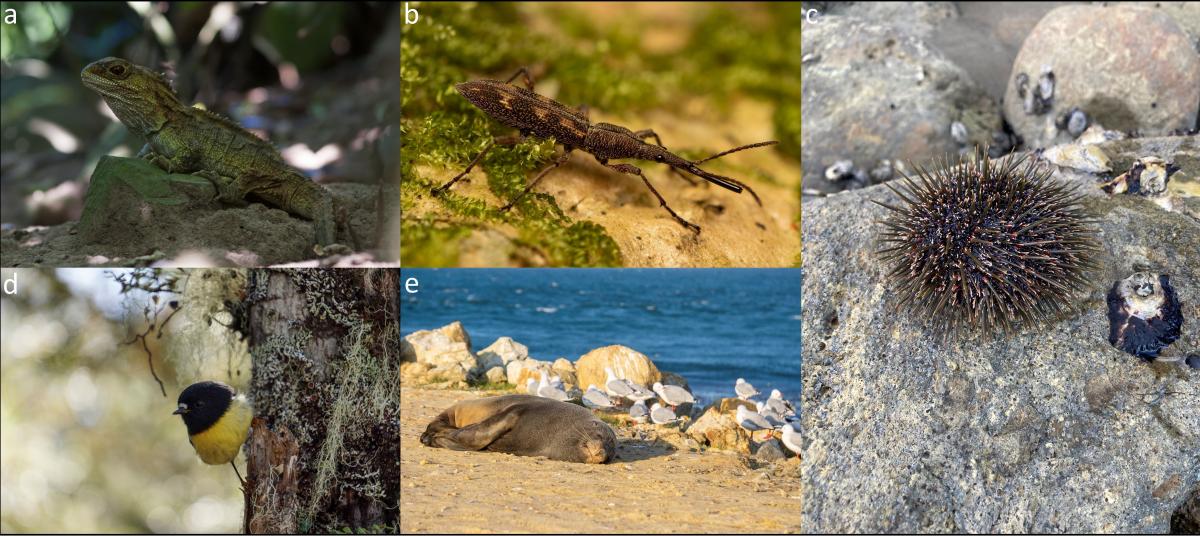Published online: August 2022
Synthesis by: Jo Monks, Department of Zoology, University of Otago (Twitter: @jo_monks_nz)

Native species within Aotearoa’s marine, freshwater, and terrestrial ecosystems are vulnerable to the effects of climate change. Understanding how species will respond to climate change is critical for future conservation planning. Photo credit: a) James Reardon b) Michaela Lambert c) Meredith Davis d-e) Michael Fox.
The evidence that the globe is heating up, and that extreme weather events are becoming more frequent and more severe, as a consequence of human actions is now irrefutable. Climate change is recognised by the Intergovernmental Science-Policy Platform on Biodiversity and Ecosystem Services (IPBES) as one of five key drivers of biodiversity loss globally and is causing atmospheric and oceanic warming, sea-level rise, increased CO2, change in rainfall patterns, and loss of snow and ice cover. In some ecosystems, impacts on biodiversity are direct and mechanisms are relatively well understood. Take coral bleaching on the Great Barrier Reef, and most recently in Doubtful Sound (Fiordland), for example. Coral bleaching involves a breakdown of the symbiotic relationship between corals and algae, which is very sensitive to changes in the physical and chemical environment surrounding the corals. Short periods of high temperature disrupt the symbiosis, resulting in the loss of the brown symbionts and hence the “bleaching”. Further, our oceans are becoming more acidic, decreasing the rate at which marine organisms—like corals—build their calcareous structures. However, for many species and ecosystems, our understanding of mechanisms by which a changing climate is impacting biodiversity is in its infancy.
In Aotearoa, climate change is considered one of the main threats to biodiversity alongside invasive species (like rats and exotic pine trees), land use change and pollution. Recent reviews by Cate Macinnis-Ng, Linda Keegan and their co-authors highlight that although climate change poses a direct threat to many of Aotearoa’s unique species and ecosystems, most ecologically meaningful impacts of climate change on biodiversity are indirect and due to exacerbation of existing threats. A powerful 2019 article by Lyn Carter highlights the importance of merging traditional ecological knowledge and science to understand impacts of climate change and improve future planning.
The most compelling evidence to date for climate change impacts in Aotearoa comes from the marine environment where sea level rise, ocean warming, and ocean acidification are the most influential processes. Effects of warming oceanic temperatures and ocean acidification are impacting a wide range of marine species from macroalgae to mangroves and molluscs to marine mammals. Molluscs are particularly vulnerable including cockles and pipi which are also important mahinga kai species. Seabirds are also disproportionately affected, with reduced ocean productivity as a consequence of warming sea temperatures and increased frequency and intensity of storms impacting migrating birds. Freshwater species, such as native īnanga (galaxiids), are particularly susceptible to extreme flood and drought frequencies and increased water temperatures. In the terrestrial environment, climate change impacts include increasing sex bias in tuatara, where male hatchlings are produced at higher incubation temperatures, and alpine species vulnerable to predation by invasive mammals are likely to face increased predation pressure as the alpine zone becomes climatically suitable for a greater range of mammalian pests like rats and possums.
However, the examples to date are just a start into understanding the variety of impacts climate change is likely to exert on our native flora and fauna, and the mechanisms underlying these impacts. A coordinated effort inclusive of both scientific and Mātauranga Māori approaches is urgently needed to understand climate change impacts on biodiversity in Aotearoa in a holistic way. We will then need a strongly interdisciplinary and inclusive approach to conservation planning for biodiversity in our rapidly warming whenua, awa and moana.
Relevant literature:
Carter L. 2019. He korowai o Matainaka / The cloak of Matainaka: Traditional ecological knowledge in climate change adaptation – Te Wai Pounamu, New Zealand. New Zealand Journal of Ecology 43: 3386. https://dx.doi.org/10.20417/nzjecol.43.27
Etherington TR, Peltzer DA, Wyse SV. 2022. Future climates are predicted to alter the potential distributions of non-native conifer species in New Zealand. New Zealand Journal of Ecology 46: 3473. https://newzealandecology.org/nzje/3473.pdf
Grayson KL, Mitchell NJ, Monks JM, Keall SN, Wilson JN, Nelson NJ. 2014. Sex ratio bias and extinction risk in an isolated population of tuatara (Sphenodon punctatus). PLOS One 9: e94214. https://journals.plos.org/plosone/article?id=10.1371/journal.pone.0094214
Hiscock JA, Chilvers BL. 2014. Declining eastern rockhopper and erect-crested penguins on the Antipodes Islands, New Zealand. New Zealand Journal of Ecology 38: 124-131. https://newzealandecology.org/nzje/3097
Keegan LJ, White RSA, Macinnis-Ng C. 2022. Current knowledge and potential impacts of climate change on New Zealand’s biological heritage. New Zealand Journal of Ecology 46: 3467. https://newzealandecology.org/nzje/3467
Macinnis-Ng C, McIntosh AR, Monks JM, Waipara N, White RSA, Boudjelas S, Clark CD, Clearwater MJ, Curran TJ, Dickinson KJM, Nelson N, Perry GLW, Richardson SJ, Stanley MC, Peltzer DA. 2021. Climate change impacts exacerbate conservation threats in island systems: A New Zealand case study. Frontiers in Ecology and the Environment 19: 216–224. https://esajournals.onlinelibrary.wiley.com/doi/pdfdirect/10.1002/fee.2285
